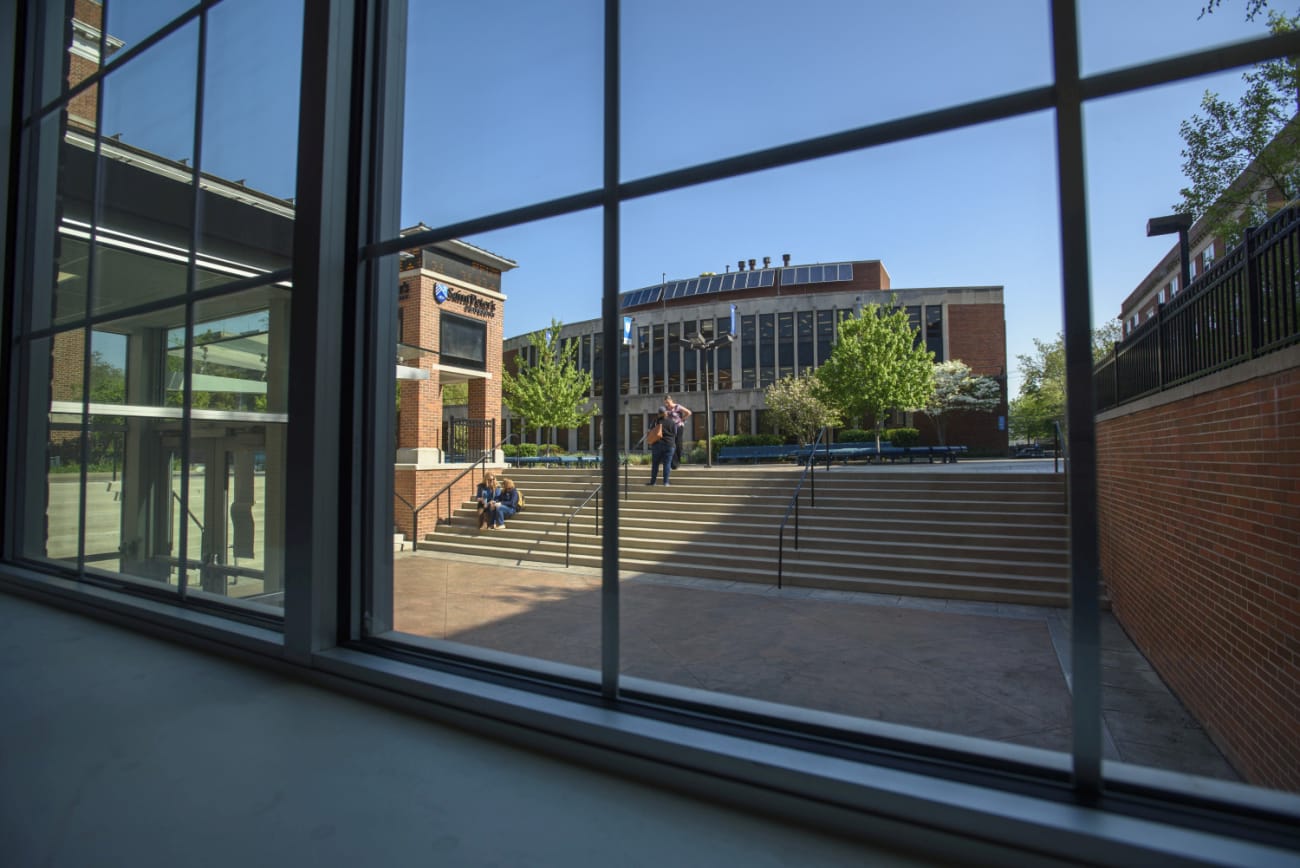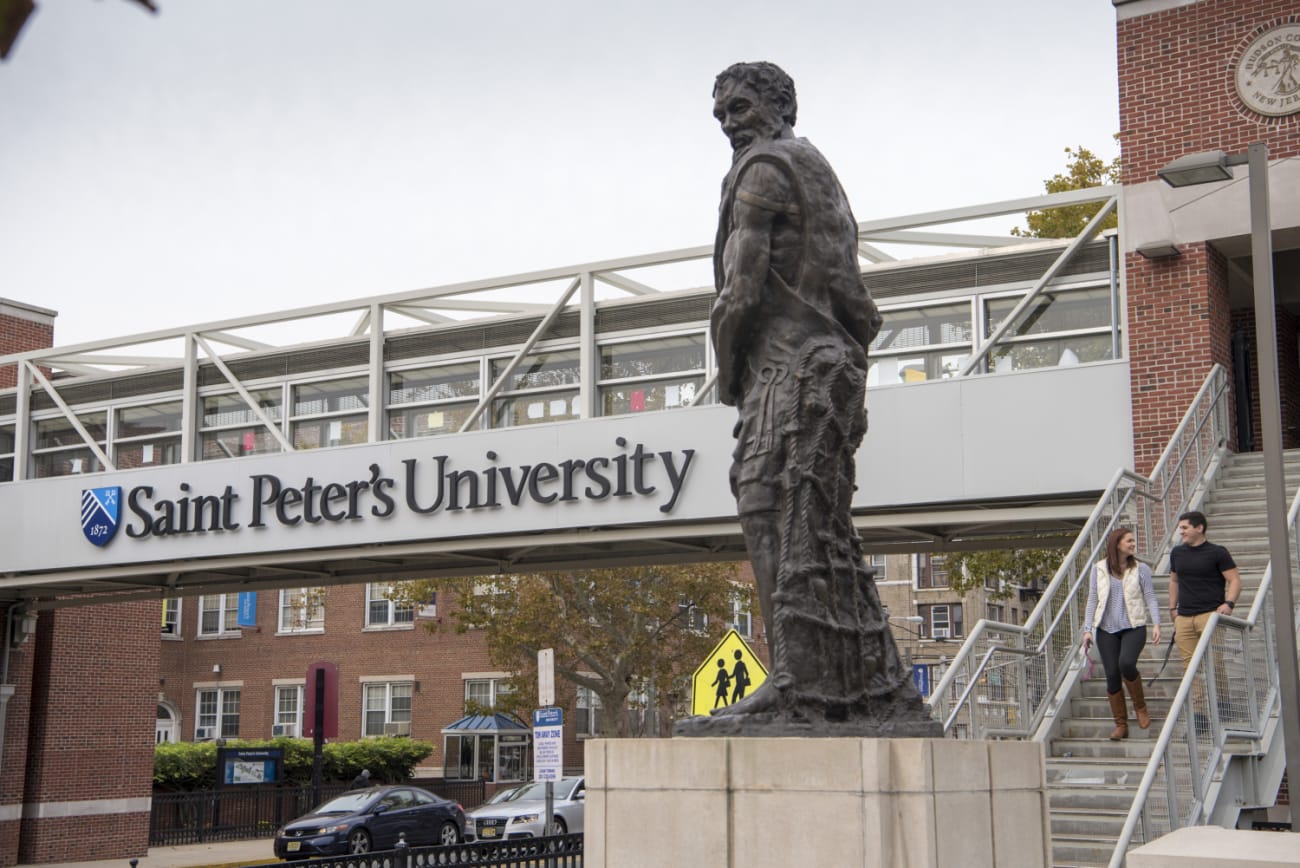While scholarships are not available to graduate students, The School of Business and the Data Science Institute has several opportunities for students to work on campus and conduct research with faculty for a reduction in tuition.

Saint Peter's University

Introduction
Transformative. Affordable. Careers.
What happens when you put one of the world’s greatest teaching organizations next to one of the greatest cities in the world? You get Saint Peter’s University, a Jesuit institution of higher education just minutes from New York City, a global center of culture, entertainment, business, and, most importantly, opportunity.
Preparing for more than just a career.
Saint Peter’s University students come to earn a degree but leave with so much more. Our Jesuit-based education will inspire you to be a caring, contributing member of society.
Experience Peacock pride.
There’s a lot to cheer about at Saint Peter’s University. With 19 intercollegiate sports, we’re one of 11 NCAA Division I universities in the Metro Atlantic Athletic Conference.
Our Mission
Saint Peter’s University, inspired by its Jesuit, Catholic identity, commitment to individual attention, and grounding in the liberal arts, educates a diverse community of learners in undergraduate, graduate, and professional programs to excel intellectually, lead ethically, serve compassionately and promote justice in our ever-changing urban and global environment.
Early Days of Saint Peter’s College
Saint Peter’s College, the Jesuit College of New Jersey, was founded as a liberal arts college for men in 1872. When classes first started in Jersey City on September 2, 1878, seventy-one students originally enrolled in the Preparatory Department.
That number grew to one hundred and twenty-three by year’s end. They aged from ten to fifteen, and thus none of them were doing college-level work. As more students arrived, work began on a new school building on Grand Street in 1899 (pictured right).
By 1900, the College had granted 63 Bachelor's degrees and 26 Master’s degrees. Five years later, the College and Saint Peter’s High School, though located in the same building, were distinct academic institutions.
From 1918 to 1930, the College closed down due to the impact of World War I and because Jesuit superiors wanted to concentrate their manpower in other colleges on the East Coast. As noted in the College yearbook, “The classrooms went empty. The faculty closed their mark books, and left for the battlefields.
A New Beginning
Saint Peter’s reopened in 1930 on the fourth floor of the Chamber of Commerce Building in downtown Jersey City, and women were admitted to the Evening Session for the first time. Robert I. Gannon, S.J., was Dean.
With the re-birth of Saint Peter’s in 1930, Rev. Gannon named the Peacock the official mascot of the College, reflecting the spirit of “resurrection and eternal life.” The peacock also ties the College to the settling of Jersey City, originally called “Pavonia,” or “Land of the Peacock.”
Reverend Gannon introduced six new Jesuit faculty members, who brought new vigor and outlook to the College, stressing, as their predecessors had done, a strong Catholic liberal arts program, the hallmark of a Jesuit education. By 1933, the College had made serious efforts to move from downtown Jersey City to its present site on the former Edward Young estate.
In 1936, the College moved to its present location on Kennedy Boulevard in Jersey City. Changes were gradually made on the new campus (among other buildings, McDermott Hall, Dinneen Hall, the Yanitelli Recreational Center, and Whelan Hall were started in 1949, 1956, 1973, and 1992, respectively).
Growth and Expansion
Saint Peter’s officially became fully coeducational in 1966 when women were admitted to the Day Session, although 35 women had actually been enrolled in 1944 in order to keep the College occupied during difficult financial times.
In 1975 Saint Peter’s established a branch campus, a “college for adults,” in Englewood Cliffs, New Jersey, and began working to improve the Jersey City campus, with renovations that included the conversion of the grass quad into the concrete quad on campus today.
The College offered its first graduate program in education in 1980. Also in 1980, Saint Peter’s welcomed resident students onto campus for the first time.
The 1990s proved to be a decade of expansion and growth, with dramatic increases in enrollment and the addition of more residence halls to accommodate the growing student body.
Saint Peter’s College celebrated its 130th Anniversary in 2002.
On August 17, 2012, Saint Peter’s College officially became known as Saint Peter’s University.
Saint Peter’s University
Saint Peter’s University remains faithful to its commitment to the educational mission of the Society of Jesus. Saint Peter’s University, inspired by its Jesuit, Catholic identity, commitment to individual attention, and grounding in the liberal arts, educates a diverse community of learners in undergraduate, graduate, and professional programs to excel intellectually, lead ethically, serve compassionately and promote justice in our ever-changing urban and global environment.
Today, President Eugene J. Cornacchia leads the University onward toward a promising future. Saint Peter’s University is a landmark on Kennedy Boulevard in Jersey City, and also offers several off-campus locations for adult undergraduate and graduate students.
Statistics
International students:
4%
0Student to faculty ratio:
11 to 1
Gallery
Admissions
In addition to a completed graduate application, students must provide the following for review:
Earned a Bachelor’s degree from a regionally accredited college/university or international equivalent. Transcripts must be sent directly from your secondary school, university or an EducationUSA advisor.
Academic transcripts with English Translation from all colleges and universities attended. Although not necessary, if you have your transcripts evaluated, you must use a NACES member company such as WES, ECE, EP, IEE, or SpanTran.
- For those that choose SpanTran, please choose the Divisional Course Analysis and use the SpanTran application for Saint Peter’s University for a discount.
- For those that choose IEE, please use their application for Saint Peter’s University for a discount.
Applicants with a Bachelor’s degree from universities in India must upload a complete undergraduate transcript, including all semester mark sheets, consolidated transcript, and degree certificate, as one (1) PDF in chronological order, to be reviewed for admission.
Unofficial transcripts are acceptable for admission decisions; however official transcripts, sent from your previous university, will be necessary for I-20 processing and enrollment into your program.
Proof of English proficiency (one of the following scores must be sent directly from the testing agency).
- TOEFL 79 IBT or TOEFL Essentials 8.5 Our ETS code for TOEFL is 2806
- IELTS 6.5 (overall).
- Pearson PTE Academic 53
- Completion of ELS Language Center course of 112, Kaplan Advanced Level or FLS Language Center level 15.
* The Duo Lingo English Proficiency Test is no longer accepted. Effective for the summer and fall 23 term.
Personal statement (500) words or more.
2–3 recommendation letters.
Résumé. Additional criteria may be required depending on the program/degree.
Scholarships and Funding
Alumni Statistics
English Language Requirements
Certify your English proficiency with the Duolingo English Test! The DET is a convenient, fast, and affordable online English test accepted by over 4,000 universities (like this one) around the world.




